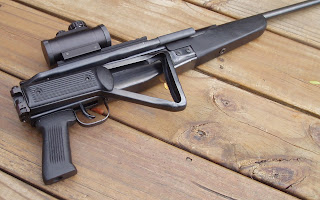With the barrel epoxied and pinned back into the breech block, I was finally able to begin reassembly. For the most part, it's just a reverse of Part 1 found here.

Started by smearing a thin film of moly grease on the inside and outside of the sliding compression chamber. I used Honda moly 60 grease. Look for it at motorcycle shops near you. It's used to lube driveshafts.

The slot in the compression tube accepts the front of the anti-beartrap safety. You'll figure it out.

Piston also gets a thin coat of moly--inside and out.

Not really shown here: From part one, the pin at the rear of the anti-beartrap mechanism was reinstalled and peened.

After installing the piston, I used a dental pick to align the holes for the cocking lever.

Like so.

Spring and spring guide? Yep, moly'd--then they took a ride in the spring compressor.

Trigger and sear got the treatment, too. Moly for everyone!

Started the multi-purpose retention pin. It holds the endcap, trigger, and sear in position.

Inserted an appropriately sized transfer punch from the opposite side through the trigger blade and sear.

Tapped the pin through. Not shown: Peened the end of the pin so it won't vibrate loose.

Moly on the cocking lever at the contact points.

Fit the end into the piston first, then the pivot at the rear.

And grease the pivot pin. Tighten snugly.

Trigger spring is a direct action against the sear. Fit the spring into the rear of the sear then hook the rear over the metal "V" shape formed into the endcap.

Like so. The trigger dropped over 2 pounds of pull weight from simply polishing and greasing the trigger, sear, and piston rod's cocking notch surfaces.

Another view.


Reinstall the two M6 stock attachment bolts.

About time. Mounted the modified Weaver base from Part 3.


Installed a spare red dot sight from buddy Joe.

Another view or three



This is a bit out of sequence, but I wondered if using a rubber bushing between the action and the stock would affect accuracy?

Removed the stock and installed a 0.125" rubber washer. The mounting bolt runs right through. This isolates the breech/barrel assembly slightly. Helpful? Who knows?

Mentioned in an earlier post that I'd free-floated the barrel. A sheet of paper just fits between the barrel and the forend. Again, is this helpful to accuracy? Dunno yet. I've changed and altered so many aspects of this gun... I can say with absolute certainty that the gun now has a much smoother firing cycle than before and it hasn't lost any power.
I fired about 100 shots then set up the chrony.
Here's the 10 shot string with .22 cal RWS Hobbys
552.1
553.2
552.1
555.9
554.4
556.6
554.3
552.1
552.3
556.4
So the velocity is still ridiculously consistent. Truthfully, if I saw this shot string posted for a BAM B3-1, I'd think the guy's chrony was broken or he'd been drinking heavily while posting. I fired 4 other guns across the chrony and they all posted appropriate numbers.
It's really interesting to me that both pre and post tune, the gun was shooting almost identical speeds (There's a pre-tune up 10-shot string in part one.) -- especially considering I used a different mainspring. I gained smoothness, lighter trigger pull, and a very slightly tighter velocity spread (only 4.5 fps from highest to lowest). How can this cheap spring gun have this kind of shot-to-shot velocity consistency? I wish I had some kind of wisdom to impart about this, but I'm just as surprised.
One more post to go on this gun. Gotta take care of that muzzle.
0 comments:
Post a Comment